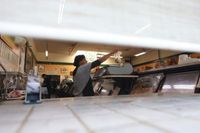Residents across the San Francisco Bay Area were abruptly awakened in the early hours of September 22, 2025, as a magnitude 4.3 earthquake struck Berkeley, California, marking the largest temblor to hit the region in nearly three years. According to the United States Geological Survey (USGS), the quake struck at 2:56 a.m., its epicenter pinpointed at the intersection of Dwight Way and Piedmont Avenue, just south of the iconic Cal Memorial Stadium and squarely on the notorious Hayward Fault line. The earthquake’s depth was recorded at roughly 4.8 miles beneath the surface, giving it enough punch to rattle windows, nerves, and shelves throughout the East Bay and beyond.
“It felt like if someone grabbed the room and shook it,” recalled David Camero, a 19-year-old UC Berkeley sophomore, who lives just a couple of blocks from the epicenter. His roommate, Charlie Tarver, an 18-year-old freshman, echoed the sentiment, describing it as “the most intense earthquake I’ve felt.” For many students—some new to California—the experience was both startling and educational, a visceral reminder of the region’s seismic hazards.
The quake’s impact rippled far beyond Berkeley. According to USGS data and reporting by the Mercury News, residents in every Bay Area county felt the shaking, with reports streaming in from as far north as Santa Rosa and Sacramento, and as far south as Monterey and Salinas. More than 22,000 people used the USGS’s “Did You Feel It?” tool to share their experiences, underscoring the quake’s wide reach. The shaking, which lasted three to five seconds for those near the epicenter, was enough to topple toothbrushes, unsettle pets, and send products tumbling from store shelves.
While the quake’s magnitude was initially reported as 4.6, USGS soon revised it down to 4.3. Sarah Minson, a research geophysicist with the USGS Earthquake Science Center, told ABC7 News, “Shaking is variable and it depends a lot on your location, what kind of building you’re in, what kind of land you’re standing on. However, this being such a small magnitude earthquake, shaking from it is going to be pretty low everywhere, certainly enough to be impactful for people, for them to feel it, for it to be upsetting, potentially even to knock over things very close to the epicenter. But in general, we wouldn’t expect to see, for example, structural damage from an earthquake this small.”
Indeed, the physical damage was mostly minor, though not insignificant for some local businesses. Magnani’s Poultry on Hopkins Street in North Berkeley lost a front window, while a nearby cheese shop saw a jar of sundried tomatoes shatter on the floor. In Oakland’s Montclair neighborhood, a large glass window also gave way to the quake’s force. “The movement made the pressure of the glass just pop at that point, because this glass is very thick. It’s a quarter inch, so it normally doesn’t break easy,” explained Abraham Molina of Glass Solutions CA. Other stores, like Cask, a local spirits shop, escaped unscathed—though manager Tim Martinez admitted, “Everything was fine, except for my nerves. It felt like I was in a big boat, and I got broadsided by a wave.”
Fortunately, there were no reports of major injuries or significant structural damage. First responders in San Francisco, led by Mayor Daniel Lurie, quickly assessed the city for impacts, while the Oakland Fire Department reported no significant emergency calls related to the quake. UC Berkeley’s facilities personnel conducted campus inspections and found no notable impacts as of mid-morning, according to a university spokesperson.
The seismic activity didn’t stop with the initial jolt. Two smaller aftershocks were recorded in Berkeley on Monday morning—a magnitude 2.3 at 7:44 a.m. and a magnitude 2.6 at 8:01 a.m.—followed by a preliminary magnitude 3.0 aftershock at 6:21 p.m. near the original epicenter. According to the USGS, the area of the quake and its aftershocks encompasses dozens of residences, bustling commercial stretches like College Avenue, and significant portions of the Cal campus and student housing.
For many, the earthquake was a literal wake-up call—both physically and in terms of preparedness. “This is not an earthquake that one would expect to cause structural damage or injuries,” Minson reiterated to Mercury News. “But near the epicenter it can knock things over and be frightening. It’s a reminder about the hazards of earthquakes. We should be prepared for them, but not to be scared of them. Most are small magnitudes.”
The USGS forecasted a 24% chance of a magnitude 3 or larger aftershock in the subsequent week, with a 3% chance of a magnitude 4 or larger, and less than 1% chance of a magnitude 5 or larger. The Chronicle noted that, statistically, any earthquake brings a slight chance—roughly 5%—that a larger one will follow within a week. However, the relatively low number of aftershocks from Monday’s quake correlates with a lower risk of it being a foreshock to something more severe. The USGS put the chance of a magnitude 5.0 or higher quake in the area in the following week at just 0.2%.
Many Bay Area residents received earthquake alerts on their phones, though some notifications arrived during or even after the shaking. As San Francisco Chronicle explained, this is not unusual for those close to the epicenter, as seismic waves can reach people before electronic alerts do.
The Hayward Fault, which runs directly under Memorial Stadium at UC Berkeley and through several East Bay cities, remains a focus of concern for seismologists. The Hayward-Rodgers Creek Fault system has a 33% chance of producing a dangerous quake in the next 30 years, according to the Mercury News. The last major earthquake in the Bay Area was the magnitude 6.9 Loma Prieta earthquake on October 17, 1989, which killed 62 people and caused $6 billion in damage, including collapsed buildings and freeways. More recently, a magnitude 6.0 quake struck Napa in August 2014, damaging hundreds of buildings but resulting in no fatalities.
Many current Bay Area residents were either not living in the region or not yet born during the 1989 disaster. To address this, agencies like the ShakeAlert Earthquake Early Warning System at UC Berkeley work to educate newcomers and long-time residents alike. “Berkeley has a high population of students coming in from around the state and the world,” said Samantha Stanley, a regional coordinator with ShakeAlert. “A lot of students aren’t aware of what to do in an earthquake. Their understanding is from TV shows and movies. We have some work to do in getting the word out.” She emphasized, “There’s very little warning. There aren’t earthquake conditions like with tornadoes or hurricanes where we can see them forming. It’s just a whole different ballgame.”
BART, the Bay Area’s vital transit system, responded by temporarily reducing train speeds for safety track inspections, but quickly resumed normal service after finding no damage. The episode served as a reminder for businesses, residents, and city officials alike to stay prepared for the possibility of a much larger event—one that, while rare, remains an ever-present risk in this tectonically active region.
While the September 22 quake may have left only a few broken windows and rattled nerves in its wake, it underscored the importance of readiness in earthquake country—a lesson the Bay Area, with its long seismic history, cannot afford to forget.




